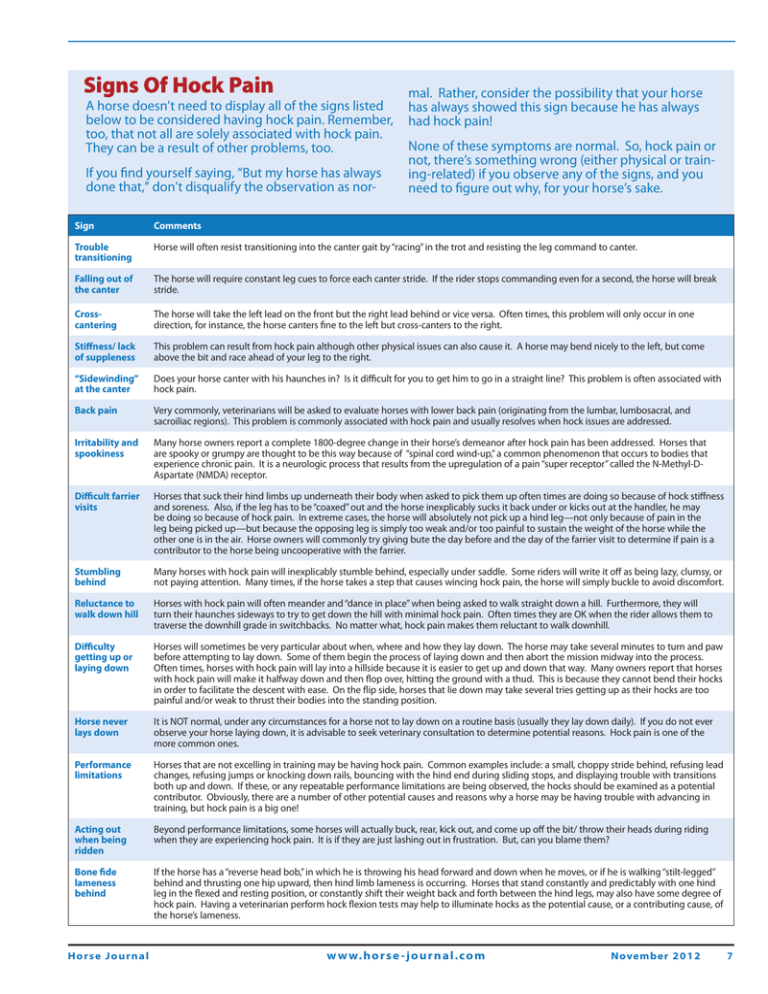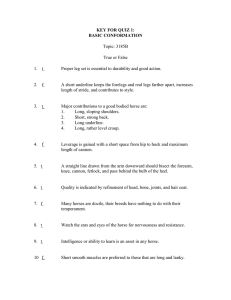Signs Of Hock Pain
advertisement

Signs Of Hock Pain A horse doesn’t need to display all of the signs listed below to be considered having hock pain. Remember, too, that not all are solely associated with hock pain. They can be a result of other problems, too. If you find yourself saying, “But my horse has always done that,” don’t disqualify the observation as nor- mal. Rather, consider the possibility that your horse has always showed this sign because he has always had hock pain! None of these symptoms are normal. So, hock pain or not, there’s something wrong (either physical or training-related) if you observe any of the signs, and you need to figure out why, for your horse’s sake. Sign Comments Trouble transitioning Horse will often resist transitioning into the canter gait by “racing” in the trot and resisting the leg command to canter. Falling out of the canter The horse will require constant leg cues to force each canter stride. If the rider stops commanding even for a second, the horse will break stride. Crosscantering The horse will take the left lead on the front but the right lead behind or vice versa. Often times, this problem will only occur in one direction, for instance, the horse canters fine to the left but cross-canters to the right. Stiffness/ lack of suppleness This problem can result from hock pain although other physical issues can also cause it. A horse may bend nicely to the left, but come above the bit and race ahead of your leg to the right. “Sidewinding” at the canter Does your horse canter with his haunches in? Is it difficult for you to get him to go in a straight line? This problem is often associated with hock pain. Back pain Very commonly, veterinarians will be asked to evaluate horses with lower back pain (originating from the lumbar, lumbosacral, and sacroiliac regions). This problem is commonly associated with hock pain and usually resolves when hock issues are addressed. Irritability and spookiness Many horse owners report a complete 1800-degree change in their horse’s demeanor after hock pain has been addressed. Horses that are spooky or grumpy are thought to be this way because of “spinal cord wind-up,” a common phenomenon that occurs to bodies that experience chronic pain. It is a neurologic process that results from the upregulation of a pain “super receptor” called the N-Methyl-DAspartate (NMDA) receptor. Difficult farrier visits Horses that suck their hind limbs up underneath their body when asked to pick them up often times are doing so because of hock stiffness and soreness. Also, if the leg has to be “coaxed” out and the horse inexplicably sucks it back under or kicks out at the handler, he may be doing so because of hock pain. In extreme cases, the horse will absolutely not pick up a hind leg—not only because of pain in the leg being picked up—but because the opposing leg is simply too weak and/or too painful to sustain the weight of the horse while the other one is in the air. Horse owners will commonly try giving bute the day before and the day of the farrier visit to determine if pain is a contributor to the horse being uncooperative with the farrier. Stumbling behind Many horses with hock pain will inexplicably stumble behind, especially under saddle. Some riders will write it off as being lazy, clumsy, or not paying attention. Many times, if the horse takes a step that causes wincing hock pain, the horse will simply buckle to avoid discomfort. Reluctance to walk down hill Horses with hock pain will often meander and “dance in place” when being asked to walk straight down a hill. Furthermore, they will turn their haunches sideways to try to get down the hill with minimal hock pain. Often times they are OK when the rider allows them to traverse the downhill grade in switchbacks. No matter what, hock pain makes them reluctant to walk downhill. Difficulty getting up or laying down Horses will sometimes be very particular about when, where and how they lay down. The horse may take several minutes to turn and paw before attempting to lay down. Some of them begin the process of laying down and then abort the mission midway into the process. Often times, horses with hock pain will lay into a hillside because it is easier to get up and down that way. Many owners report that horses with hock pain will make it halfway down and then flop over, hitting the ground with a thud. This is because they cannot bend their hocks in order to facilitate the descent with ease. On the flip side, horses that lie down may take several tries getting up as their hocks are too painful and/or weak to thrust their bodies into the standing position. Horse never lays down It is NOT normal, under any circumstances for a horse not to lay down on a routine basis (usually they lay down daily). If you do not ever observe your horse laying down, it is advisable to seek veterinary consultation to determine potential reasons. Hock pain is one of the more common ones. Performance limitations Horses that are not excelling in training may be having hock pain. Common examples include: a small, choppy stride behind, refusing lead changes, refusing jumps or knocking down rails, bouncing with the hind end during sliding stops, and displaying trouble with transitions both up and down. If these, or any repeatable performance limitations are being observed, the hocks should be examined as a potential contributor. Obviously, there are a number of other potential causes and reasons why a horse may be having trouble with advancing in training, but hock pain is a big one! Acting out when being ridden Beyond performance limitations, some horses will actually buck, rear, kick out, and come up off the bit/ throw their heads during riding when they are experiencing hock pain. It is if they are just lashing out in frustration. But, can you blame them? Bone fide lameness behind If the horse has a “reverse head bob,” in which he is throwing his head forward and down when he moves, or if he is walking “stilt-legged” behind and thrusting one hip upward, then hind limb lameness is occurring. Horses that stand constantly and predictably with one hind leg in the flexed and resting position, or constantly shift their weight back and forth between the hind legs, may also have some degree of hock pain. Having a veterinarian perform hock flexion tests may help to illuminate hocks as the potential cause, or a contributing cause, of the horse’s lameness. Horse Journal w w w. h o r s e - j o u r n a l . co m November 2 0 1 2



